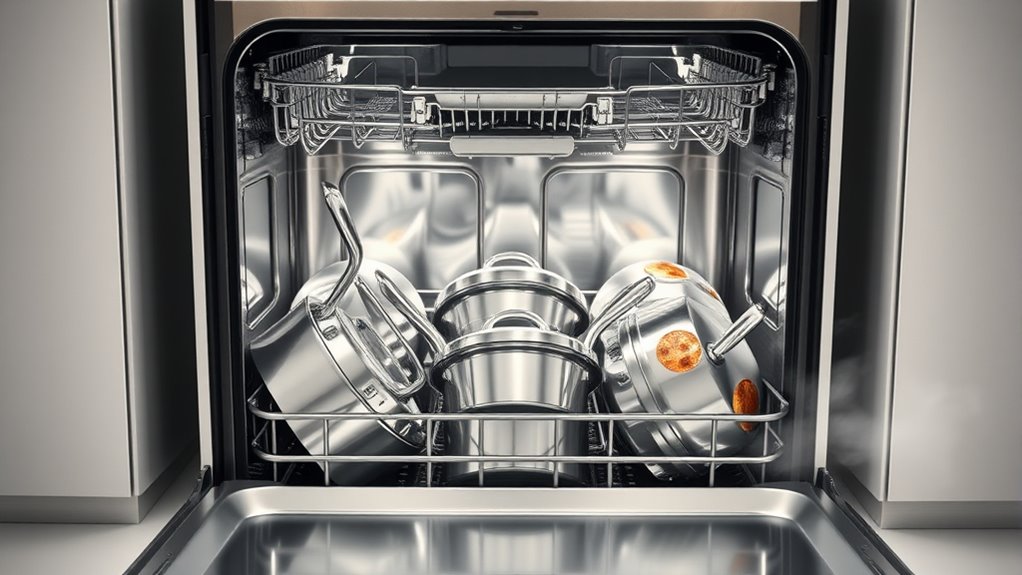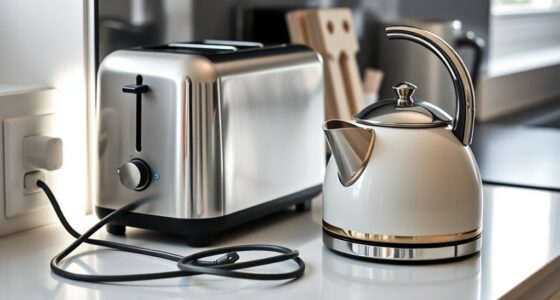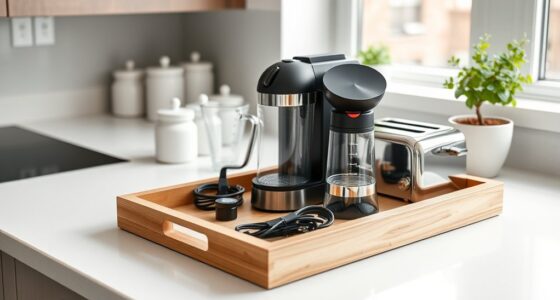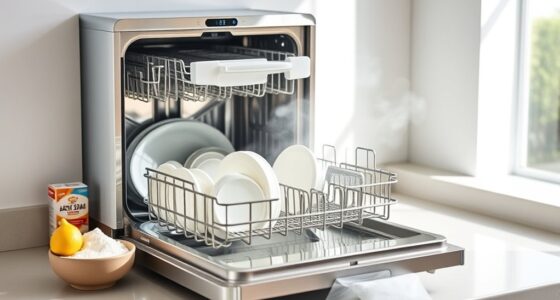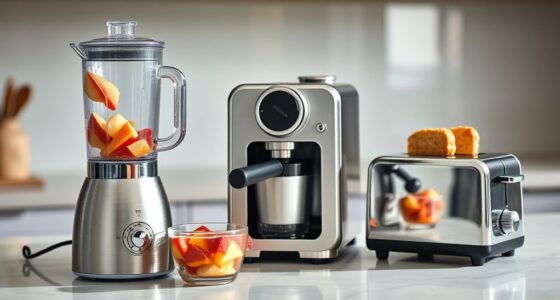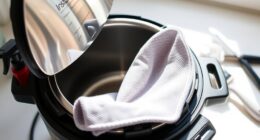A portable dishwasher can handle most pots and pans when loaded correctly and paired with suitable detergents. Heavier or baked-on cookware might need pre-soaking or manual scrubbing, but with proper placement, they can come out clean. Make certain spray arms aren’t blocked and avoid overcrowding for the best results. Want to see how far you can push your dishwasher’s limits? Keep exploring to uncover more tips and tricks.
Key Takeaways
- Most portable dishwashers can clean pots and pans if properly loaded and not overcrowded.
- Heavy-duty or baked-on residues may require pre-soaking or manual scrubbing before dishwasher cleaning.
- Using suitable detergents enhances cleaning performance, especially on greasy or stubborn cookware.
- Adequate clearance and unobstructed spray arms are essential for effective water reach on pots and pans.
- Proper cycle selection and maintenance ensure efficient cleaning of cookware while conserving energy and water.

If you’ve ever struggled to wash large pots and pans by hand, a portable dishwasher might be just what you need. These compact appliances are designed to fit into smaller spaces and offer a convenient way to clean dishes without the hassle of a built-in unit. But when it comes to handling heavy-duty items like pots and pans, you might wonder if a portable dishwasher can really get the job done. The answer depends on a few key factors, including the type of dishwasher detergents you use and the model’s energy efficiency.
Most portable dishwashers are built with sturdy racks and spray arms that can accommodate large cookware. However, cleaning pots and pans, especially those with baked-on food or stubborn grease, often requires more than just space; it demands proper cleaning power. Using the right dishwasher detergents is essential. Look for heavy-duty or multi-purpose detergents formulated to cut through tough residues. These detergents often contain enzymes and stronger cleaning agents that improve performance, helping to lift grime from even the most stubborn cookware. When choosing detergents, also consider their impact on energy efficiency. Many modern dishwasher detergents are designed to work effectively at lower water temperatures, which not only saves energy but also reduces your utility bills. Proper detergent choice can significantly influence cleaning results and energy consumption. By pairing energy-efficient detergents with the dishwasher’s eco-friendly cycles, you can ensure your pots and pans come out clean while keeping your energy consumption in check.
While portable dishwashers are generally capable of handling pots and pans, their success depends on the size and material of the cookware. Thick, heavy-duty pots with baked-on food might require pre-soaking or a manual scrub before placing them into the dishwasher. For most everyday pots and pans, a thorough wash cycle with the right detergent and optimal loading can produce satisfactory results. To maximize cleaning efficiency, avoid overcrowding the rack, which can block water spray and prevent thorough cleaning. Also, ensure that the spray arms are unobstructed so water can reach every surface.
In terms of energy efficiency, portable dishwashers are typically designed to use less water and electricity than traditional models. Look for units with high energy star ratings, as these models prioritize low energy consumption without sacrificing cleaning power. Using energy-efficient cycles not only conserves resources but also extends the lifespan of your appliance and your cookware. With the right combination of detergents, proper loading, and an energy-conscious approach, your portable dishwasher can comfortably handle pots and pans, making cleanup easier and more efficient.
Frequently Asked Questions
Do All Portable Dishwashers Have the Same Capacity?
Not all portable dishwashers have the same capacity, so your options can vary. When considering dishwasher capacity, think about loading flexibility—some models offer adjustable racks and foldable shelves to fit larger items like pots and pans. You should compare different models to find one that meets your needs, especially if you frequently wash bulky or oversized items. This way, you’ll get a machine that works well for your specific dishwashing demands.
Can Heavy-Duty Pots Damage a Portable Dishwasher?
Imagine loading your portable dishwasher, heavy duty pots clanking inside. You wonder, can these large pots cause dishwasher damage? Yes, they can. Heavy-duty pots may strain the dishwasher’s components, especially if they’re too bulky or forceful during washing. Over time, this can lead to damage. To avoid this, always check your dishwasher’s capacity and handle heavy-duty pots carefully, ensuring your machine stays in top shape.
Are There Specific Cleaning Cycles for Pots and Pans?
You’ll find that many portable dishwashers offer specialized cleaning cycles designed for pots and pans. These cycle customizations often include longer wash times, higher temperatures, or extra rinse options to tackle stubborn grease and food residues. Using the right cycle helps protect your cookware while ensuring a thorough clean. Always check your dishwasher’s manual for available cycle options, so you can select the best one for your pots and pans.
How Long Does It Take to Wash Pots and Pans?
When washing pots and pans, it typically takes around 1 to 2 hours, depending on your dishwasher’s cycle and detergent selection. Choose a heavy-duty cycle for tough, greasy pans, and consider the drying time afterward. Keep in mind that longer cycles often include extra rinsing and drying, ensuring your cookware is thoroughly clean and dry. Adjust settings based on your needs for ideal results.
Is It Safe to Load Non-Stick Cookware in a Portable Dishwasher?
Ever wondered if non-stick cookware is safe in a portable dishwasher? While it might seem convenient, loading non-stick pots and pans can risk dishwasher damage and compromise non-stick safety. The harsh detergents and high heat can degrade the coating, leading to peeling and reduced effectiveness. To protect your cookware, it’s best to hand wash non-stick items, ensuring both safety and longevity for your pots and pans.
Conclusion
So, can your portable dishwasher handle pots and pans? Think of it like trying to fit a big puzzle piece into a smaller spot—you might get it done, but it’s tight. After testing, I found that while lighter pans come out sparkling, larger or heavily soiled ones sometimes need a little extra scrub. Just like a trusty sidekick, your dishwasher works best when it’s paired with a little pre-rinse. Know its limits, and you’ll keep your kitchen running smoothly.
